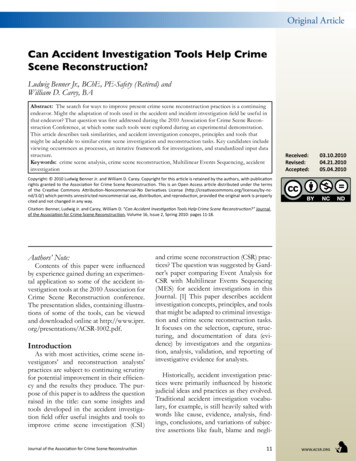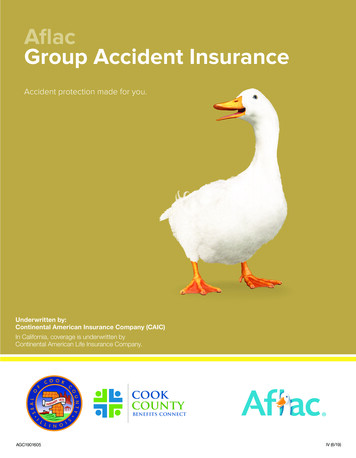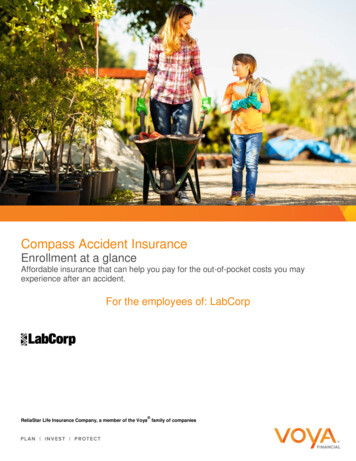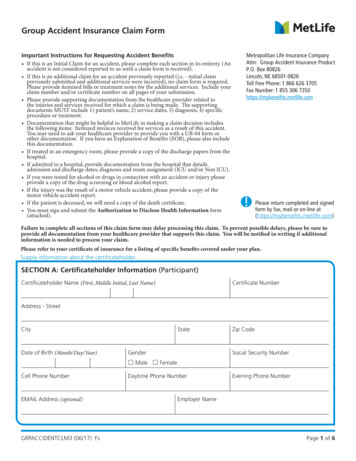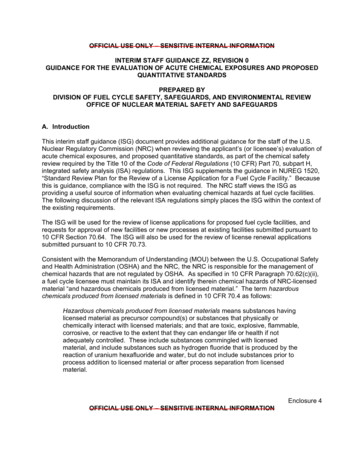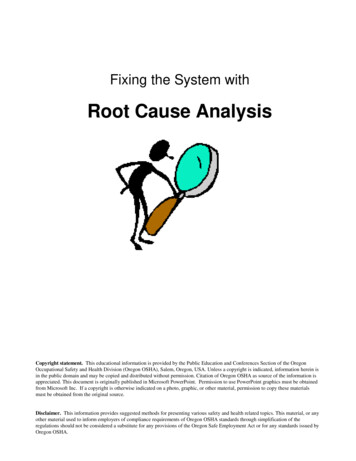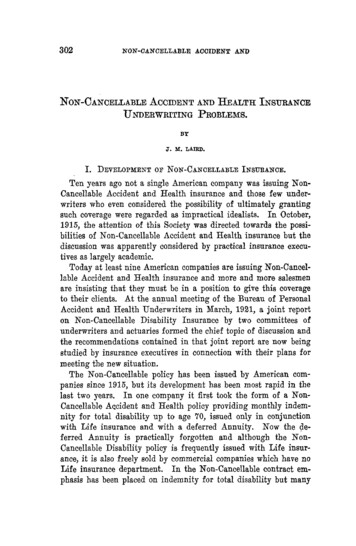
Transcription
30 I ON-CANCELLABLE ACCIDENT A N DIqON-CANCELLABLE ACCIDENT AND HEALTH INSIr2 NCEUNDERWRITING PROBLEMS.BYJ. M. LAIRD.I. D E V E L O P M E N T OF N O N - C A N O E L L A B L E INSURANCE.Ten years ago not a single American company was issuing NonCancellable Accident and Health insurance and those few underwriters who even considered the possibility of ultimately grantingsuch coverage were regarded as impractical idealists. In October,1915, the attention of this Society was directed towards the possibilities of Non-Cancellable Accident and Health insurance but thediscussion was apparently considered by practical insurance executives as largely academic.Today at least nine American companies are issuing Non-Cancellable Accident and Health insurance and more and more salesmenare insisting that they must be in a position to give this coverageto their clients. At the annual meeting of the Bureau of PersonalAccident and Health Underwriters in March, 1921, a joint reporton Non-Cancellable Disability Insurance by two committees ofunderwriters and actuaries formed the chief topic of discussion andthe recommendations contained in that joint report are now beingstudied by insurance executives in connection with their plans formeeting the new situation.The Non-Cancellable policy has been issued by American companies since 1915, but its development has been most rapid in thelast two years. In one company it first took the form of a NonCancellable Accident and Health policy providing monthly indemnity for total disability up to age 70, issued only in conjunctionwith Life insurance and with a deferred Annuity. Now the deferred Annuity is practically forgotten and although the l onCancellable Disability policy is frequently issued with Life insurance, it is also freely sold by commercial companies which have noLife insurance department. In the Non-Cancellable contract emphasis has been placed on indemnity for total disability but many
HEALTH I SURAI 'CE UNDERWRITI O PROBLEMS.303policies also provide a lump sum in case of deat by accidentalmeans and a few provide specific indemnifies for dismembermentor loss of sight.Some underwriters look upon the 1%n-Cancellable form as adangerous innovation, removing from the insurance company itslast defense against the fraudulent claimant and undermining public confidence in the well-es ablished commercial business. Manyregard it as a necessary side line which must be furnished to certainindividuals who insist upon permanent coverage but they expectthat commercial contracts will continue to be the mainstay of theAccident and Health business. Others are convinced that the NonCancellable policy fulfills a genuine public need, that it covers aslightly different field from the commercial policy and that it isdestined to be one of the most important lines of personal insurance.The only question in their minds is--Will the new field be coveredas Casualty insurance or as Accident and Health benefits with Lifeinsurance ?lid ACCIDEI 'TAND I:IEALTH BENEFITS WITH LIFE T1VSURAI 'CE.The most striking improvement in the Life insurance contractduring the last two decades has been the development of a Disability benefit as an integral part of Life insurance. Twenty yearsago only one American Life insurance company issued a Disabilityclause. Today only two of the principal companies refuse to granta Disability benefit and over 200 offer some form of Disability coverage with Life insurance. This growth has undoubtedly been dueto two causes--first, as a selling proposition the Disability benefitoffers the prospect something for himself; second, there is a genuineneed for Life insurance which recognizes that loss of earning powerby death is no more serious than loss of earning power by injuryor sicl uess. In fact, howe er great may be the family need afterthe death of the wage earner, the need is even greater if l e stilllives but is deprived of his earning power and lingers as an invalidyear after year.Partly because of legal restrictions and partly because the Disability benefit has been considered merely an inciden of Life insurance, the Disability clause has covered only permanent total disability; but the definition of permanent total disability has beencontinually liberalized. At the same time the benefits obtainablein case of such disability, occurring before a specified age, usually
304NON-CANCELLABLE ACCIDENT AND60 or 65, have been greatly increased. Starting with a provisionthat, in case of total disability which has lasted one year and is thenpresumably permanent, future premiums will be waived, the benefithas been liberalized until now at least one company provides thatany total disability which has lasted three months will be consideredpermanent within the meaning of the policy and that paymentswill begin even within the three months' period if the total disability is then classified as permanent. Under these conditions thedisabled Insured receives 10 a month per 1,000 of Life insurancewithout reduction in the amount payable to the Beneficiary. Another company provides in certain states monthly indemnity ofeither 10 or 20 per 1,000 with payments for the entire period oftotal disability with the exception of the first two weeks. It is,therefore, apparent that even now Life insurance companies havecovered the major portion of the field of total disability.At the same time Life insurance companies have introduced aprovision that in case of death by accidental means before a limitingage, usually 70, the face of the policy will be doubled. This provision was at first attacked even m o r e vigorously than the permanent total Disability benefit as a function of Life insurance but itspopularity with the insuring public has swung company after company into line until now a majority of the Life insurance companiesgrant some form of Double Indemnity in case of death by accidental means.Now that Life insurance companies provide additional sums fordeath by accidental means and cover permanent total disabilitywith a comparatively short waiting period and with an increasinglyliberal interpretation of what constitutes permanent total disability,the purchaser may obtain in one contract both Life insurance andthe most essengal portion of the coverage granted under commercial Accident and Health policies.III. COMMERCIAL ACCIDENT AND H E A L T H INSURANCE.Commercial Accident insurance as distinct from Health insurancehas been successfully issued in this country since about 1864. Ithas proven satisfactory to policyholders and profitable to the insurance companies. As the companies have acquired greater confidencein their ability to underwrite this business on a reasonable basis,they have gradually liberalized the contracts. In particular, theperiod of total disability covered by the policy has been increased
HEALTHINSURANCE U N D E R W R I T I N G PROBLEMS.305from 26 weeks to 52 weeks and then to 200 weeks. Now, with thelimit entirely removed, indemnity is payable for the whole periodof total d/sability. A smaller indemnity, usually 50 per cent., ispaid for partial disability for a period not exceeding a definitelimit, for instance, 26 weeks. Specific sums are paid for loss oflife, limb or sight. For certain favored accidents the benefits aredoubled, tripled or even quadrupled, for instance, " i f the injuriesare sustained while a passenger in or on a public conveyance provided by a common carrier for passenger service."Health insurance as issued by commercial companies dates fromabout 1897 and has not been entirely satisfactory to the public orprofitable to the companies. Just as in the case of Accident insurance, the benefits have been liberalized and the coverage extendedfrom 26 weeks to 52 weeks and finally to the entire period of disability. At the same time the conditions under which full indemnity is payable have been liberalized. A short time ago Healthpolicies covered only total disability, full indemnity being payablefor house confinement and partial indemnity for non-confinementwith a limit of 52 weeks. Now policies are issued providing fullindemnity for life for total disability, whether confined or not confined, and smaller benefits for a limited period for partial disability such as loss of one-half of the Insured's business time. Thefull effect of these more liberal provisions will probably not appearin the claim records until this business has become more mature.Although most companies have made a profit on their commercialAccident business, commercial Health insurance has on the wholebeen unprofitable. Partly on this account and partly because ofthe Influenza epidemic of 1918 Health insurance premiums havebeen increased, but it is doubtful whether the increases in premiumshave kept pace with the liberalization of the contracts. Most companies have refused to issue Health insurance except in conjunctionwith an equal amount of indemnity under an Accident policy andhave usually encouragecl the sale of Accident insurance as distinctfrom Health insurance by sales literature, contests and even extracommissions and bonuses.Both Accident and Health policies on the commercial form havebeen issued for a term of three, six or twelve months subject torenewal at the option of the company up to age 70 for Accidentinsurance and age 60 or 65 for Health insurance. Under thesecommercial policies, even though the coverage runs for not more
306NON-CAI CEI I LEACCIDENT ANDthan twelve months, the companies have felt obliged to protect hemselves by reserving the right to cancel the insurance within the term.The principal causes of cancellation are :1.2.3.4.5.Misstatement in original application,Impaired physical condition,Material reduction in earnings,Repeated claims for recurrent types of disease,Unsatisfactory moral hazard.In case of cancellation the company pays in full any valid claimfor disability incurred before the date of cancellation but avoidsany liability for further claims on that risk.Under both Accident and Health policies it is customary to revieweach case carefully at least once a year and to cancel those riskswhich do not appear to come up to the company's standard. Inpractice, this right of cancellation is exercised much less frequentlyunder contracts giving only Accident protection than under policiesgiving Health insurance. Although this right to cancel the insurance is a privilege clearly reserved to the company in the contractand is exercised only when the company feels that the policyholderdoes not come up to its standard, the person who finds himself thusdeprived of his insurance protection just at the time when he ismost likely to receive substantial claim benefits may cherish a feeling of resentment against the company, its field representative andthe Accident and Health idea.Another weakness of the commercial policy as now issued is thehigh rate of voluntary discontinuance on the part of policyholders.Too frequently the insurance has been bought as a temporary sporting propositian and if no accident or illness occurs within yearor two, the policyholder, feeling that he has no permanent interestat stake, is liable to drop the insurance. Moreover, the policieshave been sold at a flat rate regardless of age at issue and thereforea new contract can usually be secured in another company on justas favorable terms as the old policy carried.In an attempt to make the insurance more persistent, some companies have' provided that the benefits shall increase each year forfive or ten years from date of issue without a corresponding increasein the rate of premium, but this movement has merely led to theissuance of "fully accumulated" policies giving the full benefitsfrom the first year. In fact, the Accident and Health contract
H E A L T H INSURANCE UNDERWRITING PROBLEMS.307have been adjusted in such a way that it is comparatively easy foran agent or a broker to transfer business from one company toanother without substantial loss to either the salesman or the policyholder. So far as the policyholder i concerned, the very ease withwhich a policy can be secured upon a simple application withoutmedical examination makes it equally easy for him to forego theprotection at a later date if his circumstances have altered evenslightly.Under these conditions the collection of a renewal premium mayinvolve almost as much salesmanship as the securing of the originalapplication and therefore the well-established practice is to pay thesalesman practically the same rate of commission on renewal premiums as on first premiums. This has meant a comparativelyhigh total expense rate and therefore a lower return fo policyholdersthan would be possible if the business were more persistent.In an effort to furnish the public with more permanent Accidentand Health insurance at a lower expense rate, companies have nowbegun to issue Non-Cancellable contracts under which they guarantee to continue the protection up to the limiting age, usually 60or 65, without the right to terminate the insurance even though therisk should in the meantime become seriously impaired.IV. POLICY COV AOE.Partly on account of the newness of the problem and partly as areaction from the "frills" found in so many commercial policies,an attempt has been made to limit the coverage under the NonCancellable form to the one great loss--total disability caused byeither accident or sickness. The Underwriting Committee of theBureau of Personal Accident and Health Underwriters recommendsthat the Non-Cancellable policy should not cover partial disabilityfor either injuries or sickness and should not provide indemnitiesfor medical or surgical attendance, hospital fees, dismembermentor loss of sight. Apparently the Committee is not in avor ofgranting double or triple indemnity for any accident.Although Life insurance companies freely issue policies providingDouble Indemnity in case of death from accidental means, theUnderwriting Committee unanimously recommends that the l onCancellable policy should not provide a principal sum in case ofdeath by accidental means. It is considered unwise to combine inone 1Von-Cancellable contract complete coverage for total disability
308NOI -CAI CELLABLEACCIDI .NT ANDfrom either accident or disease and limited coverage for a principalsum payable only in about 10 per cent. of the total number ofdeaths, namely, "if death results from bodily injuries directly andindependently of all other causes through external, violent and accidental means."Loss of life is covered under the commercial policies but it is customary for the companies to cancel the insurance if it becomesknown that the policyholder is suffering from any serious organictrouble such as heart lesions or diabetes. It is felt that underthese conditions a slight injury is liable to result directly or indirectly in death and that occasionally a policyholder who knows thathe has a serious disease may be tempted to terminate his hfe undercircumstances which make it difficult to prove suicide.In a great many claims for death by accidental means disease hasbeen either a primary or a contributing cause and there is alwaysa danger that a court may hold that the company is liable eventhough the policyholder was in a weakened condition from someincurable disease and a trivial accident merely hastened his death.I f the accident caused total disability and the company could discuss the claim with the policyholder himself, it would have a chanceto make a fair settlement, but the company is at a decided disadvantage when the claimant is the policyholder's comely widowrepresented by an astute attorney. Because of the chance of heavyclaims and troublesome litigation with dissatisfied claimants, theUnderwriting Committee recommends that payments for loss oflife should not be granted under the Non-Cancellable policy.The principal function of the hYon-Cancellable policy is thereforeto provide monthly indemnity in case of total disability. The word"Indemnity" implies that there must be some loss suffered by theInsured. What is this loss? I t is not pain and suffering, butrather the business time of the Insured. Because the contract isone of indemnity and the loss insured against is the Insured's time,i is essential that we cover only those applicants whose time is valuable and can also be measured by some workable standard. Thatstandard requires that the applicant be engaged in a gainful occupation, and that the policy should cover only the period of the applicant's natural business usefulness. I t is not feasible to issue aNon-qancellable contract providing benefits at the old ages whereit is impossible to distinguish disability caused by accident or disease from mere cessation from active duties because of old age.
HEALTHINSURANCE U N D E R W R I T I N G PROBLEMS.309In discussing whether the limiting age should be 60 or 65, oneprominent underwriter recalled that according to statistics of theAmerican Bankers' Association out of 100 persons starting at age25 in good health 54 will at age 65 be dependent on others. Asmany persons become disabled between age 60 and 65 and as manymore might feign disability in order to draw a pension from the insurance company, the Committee recommends that no policy shouldcover disability beginning after age 60. If disability begins beforeage 60, then benefits will be paid as long as the Insured lives andsuffers total disability.Non-Cancellable policies have been issued covering from the firstday of te al disability and also excluding the first week, two weeks,four weeks or three months of total disability. Although commercial policies are almost invariably sold with coverage from the firstday, it is felt that under the Non-Cancellable policy this presentstoo great an opportunity to the policyholder to make repeated claims,particularly if he can persuade his physician that his health requireshim to spend a few weeks in Maine during the summer and in Florida during the winter. It is also felt that under a contract providing permanent protection the policyholder is fully able to take careof himself during the first two weeks and that the person who buysthe contract in good faith will prefer a somewhat lower premiumfor a contract providing coverage after a reasonable waiting period.The Underwriting Committee, therefore, recommends that the policies be issued with a waiting period of two weeks, four weeks orthree months. Although the policy with three months' eliminationis practically unknown in the commercial field, it has proven popular on the Non-Cancel]able form. Its purpose is not to cover temporary ailments but to indemnify for protracted illnesses or disabilities causing serious loss of earning power and heavy expense.V. I &TE OF DISABILITY.Under commercial policies it has been customary to comparelosses incurred with premiums earned but some companies haverecognized that with benefits and premiums constantly changing, abetter standard must be found not only for Non-Cancellable policiesbut also for the commercial. This better standald involves the" rate of disability" in number of weeks of disability per personper annum. Usually this rate of disability has been given according to the age attained while the person was disabled regardless of
310 O -CA C LL ACClD A Dwhen disability began. Strictly speaking, however, the disabilityshould he arranged according to he age at which disability beganand should show how much of this disability was experienced in eachof the first 13 weeks after disability started, how much in the secondthree months, and how much in the first year, second year, etc. InAmerican statistics now available comparatively little attention hasbeen paid to the age of the Insured or to the time elapse/[ from theoriginal date of issue. There is evidence, however, that under commercial policies as issued in the past the rate of disability due toaccident has increased only slightly with the attained age and therate of disability from sickness has remained almost constant up toage 50 and has then increased moderately to age 65. I is probable. that under the more liberal commercial policies now beingissued the rate of disability will increase more rapidly with theattained age, particularly on Health policies paying full indemnityfor life whether confined to the house or not confined.The development of/%n-Cancellable insurance is so recent thatno reliable American experience is available and we are tempted totry to estimate the rate of disability by comparison with the actualexperience on commercial policies. As commercial policies areusually issued without medical examination and as the ! onCancellable policies are issued with a strict medical examination inevery case, the rate of disability on the i on-Cancellable policy inthe first year or two after issue should be more favorable than onthe gommerciaI contract. As a partial offset to this advantage,however, it should be noted that even under the commercial policiesa medical examination is required if anything unfavorable is revealed in the application or other sources of information, and thatcommercial health policies do not cover sickness beginning within15 days after issuance.The great distinction between the two contracts is of coursethe cancellation provision. In commercial policies this right tocancel has undoubtedly removed from the companies' experience agreat many impaired lives, particularly at the older ages, and therefore under the hTon-Cancellable policies the rate of disability willincrease much more rapidly with attained age than under the commercial contracts. In order to estimate the rate of disability undera Non-Cancellable policy from the actual experience under commercial contracts, let us make the following assumptions:
HF ALTlq I N S U R A N C EUNDERWRITINGPROBLF S.311r"1. That the rate of disabil!ty in the first year will agree with theexperience on commercial policies.2. That the company cancels 1 per cent. of its commercial policieseach year becau the risk is impaired. The late Mr.Messenger in a paper on the Rate of Sickness presented tothe Actuarial Society of America in May, 1908, stated thatthe Travelers' Insurance Company at that time declined torenew from 1 per cent. to 2 per cent. of the Health policieswhen the year expired.3. That the rate of disability on policies cancelled because of impairment will be four times the rate on the normal lives notcancelled. It is doubtful whether any company would bewilling to insure these cancelled policyholders even at fourtimes the normal premium.4. That none of these impaired risks will drop their insurance andthat the mortality in this class will follow the ManchesterUnity Experience.5. That the rate of discontinuance including deaths among unimpaired lives under the Non-Cancellable policy will be 10 percent. each year for five years, then reducing by ½ per cent.each year to 5 per cent. at the end of fifteen years, and thencontinuing at 5 per cent.Applying these figures to a graduated Disability table based onexperience on commercial Disability policies adjusted to pay indemnity for life for total disability whether confined or not confined,we derive the following figures for a person entering at age 35 andfor another person entering at age 50.O N E Y E A R TER r P R E M I U M S FOR INDEMNITY OF 1 0 . 0 0 A 7J[ONTH.Age at which Disa-By Exverience onbility Begtus,Commercial Policies,35 .40 .45 . . . . . . .50. . . . . . .55. . . . . . .60 . . . . . . . 2.052.092.192.763.915.98By A umptlons for Non-Cancellable Pol]c]es.Age at Entry 35.Age at Entry 50. 2.052.513.204.747.5412.72 2.764.658.58As many of the assumptions in the above table are entirely arbitrary, the figures should be used with the utmost caution. Theymerely indicate that the rate of disability under the Non-Cancel-
312NON-CANCELLABLEACCIDENT ANDlable pohcy may be entirely different from the rate under commercial policies and that under the Non-Cancellable contracts the rateof disability beginning at age 55 may depend largely on whether thepolicy was originally issued at age 35 or at 50.Having failed to deduce any reliable rates of disability for NonCancellable policies from American Experience on commercial contracts, we naturally turn to the experience of companies in GreatBritain where on-Cancellable policies have been issued since 1885.These British companies have in turn based their premiums on thedisability experience of a friendly society, the Manchester Unity,which has published the most elaborate and carefully prepared tables available on this subject.Even though the conditions under which Non-Cancellable policiesare issued in the United States may not agree with those of the Ianchester Unity or even the British stock companies, it isessential that we have some standard Disability table as a guideand the only guide now available appears to be the ManchesterUnity Experience which has proven its value in Great Britain andcan be used in this country with perhaps slight modifications tomake it more nearly conform to American conditions.Some companies, apparently influenced by the general practiceunder commercial policies, have issued Non-Cancellable policies atthe same gross premiums for all ages at entry. Although this planhas worked fairly well in commercial business and the results onthe Non-Cancellable form may appear reasonably satisfactory fora few years, while strict selection is still effective, it contains someof the inherent weaknesses of the old assessment plan of sellingLife insurance, and because it means overcharging the young menand undercharging the old men, it must in time be abandoned infavor of a more scientific system of gross premiums based on ageat entry, just as has already been done by American Life insurancecompanies in computing premiums for permanent total Disability.As it is evident that the rate of disability under the Non-Cancellable policy will increase with the attained age, it is clear that theCompany must either:1. Issue the policy as a renewable Term with rate increasing at theend of each Term (for instance, one year renewable Termor five year renewable Term),
IIEALTII I N S U R A N C E U N D E R W R I T I N G PROBLE] .or313 2. Issue a long T e r m contract at a level premium sufficient to coverthe rate of disability h) the age of expiry.iAs the renewable Term contract with constantly increasing premium would probably be unsatisfactory and would tend to encourage a high rate of discontinuance, particularly among the betterrisks, the proper course appears to be to issue a long Term contractat a level premium depending on the age at issue. The gross premium for each age at issue will then depend on:1. The rate of disability assumed for each year up to the age atexpiry.2. The rate of mortality.3. The rate of interest.4. The loading required for expenses, contingencies and profits.If we assume that the rate of disability and mortality will followthe Manchester Unity or some similar table and that the companycan reasonably count on earning 3½ per cent. interest for the entireduration of the policy, then the actuary will compute a set of netpremiums which will be just sufficient to pay all claims if the company earns 3½ per cent. interest and experiences the rate of disability assumed in the table. The expenses can be determined fairlyaccurately by an examination of the company's commercial business with proper allowance for the new conditions introduced bythe hYon-Cancellable form. It is expected that the total expenseswill be lower than on commercial policies but higher than on Lifeinsurance policies.The rate of commission on the Non-Cancellable policy is somewhat uncertain. Companies with an organization for selling commercial policies may pay the General Agent 35 per cent. the irstyear followed by nine renewals of 17½ per cent., but companies witha Life insurance organization may prefer to pay approximately 50per cent. the firs year followed by nine renewals of 7½ per cent.As the latter schedule is approximately 7½ per cent. lower than thefirst schedule, the company with a Life insurance organization,other things being equal, may feel justified in quoting gross premiums lower than those used by the company with a commercialorganization.The Underwriting Committee recommended a provision in the21
314NON-CAI%ICELLABLEACCIDENTANDloading to cover the General Agent's commission and in additionthe following items expressed as a percentage of the gross premium:F e r Cent.First Year--Administration . . . . . . . . . . . . . . . . . . . . . .Taxes . . . . . . . . . . . . . . . . . . . . . . . . . . .Claim Settlement . . . . . . . . . . . . . . . . . . . .Medical l ees . . . . . . . . . . . . . . . . . . . . . . .Inspections . . . . . . . . . . . . . . . . . . . . . . . . .Total . . . . . . . . . . . . . . . . . . . . . . . . . . . . . . ion . . . . . . . . . . . . . . . . . . . . . .Taxes . . . . . . . . . . . . . . . . . . . . . . . . . . . . . .Claim S6ttlement . . . . . . . . . . . . . . . . . . . . .Contingencies and Profits . . . . . . . . . . . .Total . . . . . . . . . . . . . . . . . . . . . . . . . . . . . . .I t seems doubtful, however, whether the 4½ per cent. allowancefor medical expenses will be sufficient and probably this figureshould be 7 per cent., making the total for the first year 30 per cent.Using these figmres for general expenses and assuming commissions of 35 per cent. the first year followed by renewals of 17½ percent., the Committee obtained the following premiums:NON-CANCELLABLE GROSS A N N U A L P R E M I U S FOE 10 A M O N T HFOE TOTAL DISABILITY BEGINNING BEFORE A G E 80SELECT A N D PREFERRED R.IsKS.W a i t i n g Period.Age at E n t r y .2 Weeks.[L2035 . . . . . . .50 . 3.755.799.48II4 Weeks.3 Months. 2.984.798.22 1.963.326.03For a commercial Accident and Health policy giving practic
III. COMMERCIAL ACCIDENT AND HEALTH INSURANCE. Commercial Accident insurance as distinct from Health insurance has been successfully issued in this country since about 1864. It has proven satisfactory to policyholders and profitable to the insur- ance companies. As the companies have acquired greater confidence
